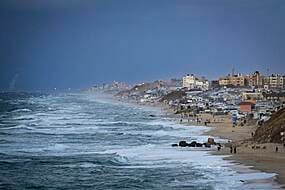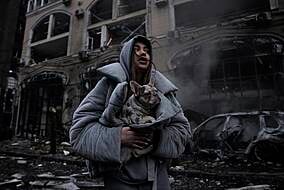Iran’s president has vowed to exact revenge over the killing of a scientist linked to Tehran’s nuclear programme as he joined other officials in blaming Israel for the murder.
Hassan Rouhani’s comments came after the death of Mohsen Fakhrizadeh on Friday.
Israel, long suspected of killing scientists a decade ago amid tensions over Tehran’s nuclear programme, has yet to comment on the attack; however, it bore the hallmarks of a carefully planned, military-style ambush.
The murder threatens to renew tensions between the US and Iran in the waning days of Donald Trump’s term in office, just as president-elect Joe Biden has suggested his administration could return to Tehran’s nuclear deal with world powers from which Mr Trump earlier withdrew.

The Pentagon announced early on Saturday that it has sent the aircraft carrier USS Nimitz back to the Middle East.
Speaking to a meeting of his government’s coronavirus taskforce, Mr Rouhani reiterated that Mr Fakhrizadeh’s death would not stop Iran’s nuclear programme, which has continued its experiments and now enriches uranium up to 4.5%, far below weapons-grade levels of 90%.
But analysts have compared Mr Fakhrizadeh to being on a par with Robert Oppenheimer, the scientist who led the US’s Manhattan Project in the Second World War which created the atom bomb.
“We will respond to the assassination of Martyr Fakhrizadeh in a proper time,” Mr Rouhani said.
He added: “The Iranian nation is smarter than falling into the trap of the Zionists. They are thinking to create chaos.”

Iran’s Supreme Leader, Ayatollah Ali Khamenei, issued a statement, calling Mr Fakhrizadeh “the country’s prominent and distinguished nuclear and defensive scientist”.
He said Iran’s first priority after the killing is the “definitive punishment of the perpetrators and those who ordered it”, but did not elaborate.
Friday’s attack happened in Absard, a village just east of the capital which is a retreat for the Iranian elite. Iranian state television said an old truck with explosives hidden under a load of wood blew up near a car carrying Mr Fakhrizadeh.
As Mr Fakhrizadeh’s vehicle stopped, at least five gunmen emerged and raked the car with rapid fire, the semi-official Tasnim news agency said.
Mr Fakhrizadeh was taken to hospital but doctors were unable to revive him.
The scientist’s bodyguards were injured in the attack.
Photos and video shared online showed a Nissan sedan with bullet holes in the windscreen and blood pooled on the road.
Hours after the attack, the Pentagon announced that it had sent USS Nimitz back into the Middle East, an unusual move as the carrier already spent months in the region.
It cited the drawdown of US forces in Afghanistan and Iraq as the reason for the decision, saying “it was prudent to have additional defensive capabilities in the region to meet any contingency”.

The attack came just days before the 10-year anniversary of the killing of Iranian nuclear scientist Majid Shahriari that Tehran also blamed on Israel.
That and other targeted killings happened at at time when the so-called Stuxnet virus, believed to be an Israeli and American creation, destroyed Iranian centrifuges.
Those incidents occurred at the height of Western fears over Iran’s nuclear programme.
Tehran has long insisted its programme is peaceful. However, Mr Fakhrizadeh led Iran’s so-called Amad programme, which Israel and the West have alleged was a military operation looking at the feasibility of building a nuclear weapon.
The International Atomic Energy Agency said that “structured programme” ended in 2003.
IAEA inspectors monitor Iranian nuclear sites as part of the now-unravelling nuclear deal with world powers, which saw Tehran limit its enrichment of uranium in exchange for the lifting of economic sanctions.
After Mr Trump’s 2018 withdrawal from the deal, Iran abandoned all those limits.
Experts now believe Iran has enough low-enriched uranium to make at least two nuclear weapons if it chooses to pursue the bomb. Meanwhile, an advanced centrifuge assembly plant at Iran’s Natanz nuclear facility exploded in July in what Tehran now calls a sabotage attack.

Mr Fakhrizadeh, born in 1958, had been sanctioned by the UN Security Council and the US for his work on Amad. Iran always described him as a university physics professor.
A member of the Revolutionary Guard, he had been pictured at meetings attended by Iran’s Supreme Leader Ayatollah Ali Khamenei, a sign of his importance in Iran’s theocracy.
In recent years, US sanctions lists named him as heading Iran’s Organisation for Defensive Innovation and Research.
The State Department described that organisation last year as working on “dual-use research and development activities, of which aspects are potentially useful for nuclear weapons and nuclear weapons delivery systems”.
Iran’s mission to the UN, meanwhile, described Mr Fakhrizadeh’s recent work as “development of the first indigenous Covid-19 test kit” and overseeing Tehran’s efforts at making a possible coronavirus vaccine.







